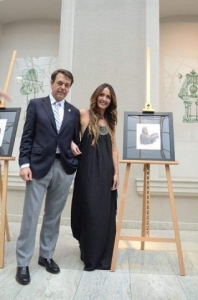Georgia in the Heart of Afghanistan: Exhibition at Tbilisi’s MOMA
“A tribute to the lives of the 29 Georgian soldiers killed in Afghanistan.” This is how Spanish artist Augusto Ferrer-Dalmau describes his collection of works on display at Tbilisi’s Museum of Modern Art.
In 2014, Dalmau, a self-taught hyperrealist artist specialized in military art, spent a week with the Georgian troops deployed in Afghanistan, just as he had done two years before with the Spanish army. The resulting works of both trips share a common message: “I want to transmit respect for those who are risking their lives for a more civilized society. Georgians should be very proud of their soldiers,” Dalmau told Georgia Today.
Currently, Georgia has 885 servicemen deployed in Afghanistan, and is the second largest troop contributor to the NATO-led mission1. Apart from the casualties, over 435 Georgian soldiers have been wounded, 35 of whom are amputees.
Georgia started contributing to the Afghan mission in 2004, a year after NATO assumed leadership of the International Security Assistance Force (ISAF) established by the United Nations Security Council. Every casualty has sparked public debate in Georgia regarding the size of the country’s deployment in Afghanistan, especially among those not favoring integration with the West.
“The psychological and physical efforts of the Georgian troops in Afghanistan are huge. Just think of how it feels walking in a sunblaze, 50 degrees Celsius, with very heavy equipment on your shoulders, surrounded by landmines, thinking that every minute could be your last,” Nodar Kharshiladze, Senior Fellow at the Georgian Foundation of Strategic and International Studies, told Georgia Today.
In Ferrer-Dalmau’s paintings these hardships are embodied by a “generic soldier” that looks alike in most paintings, his identity being given by the uniform and the flag. This contrasts with the deeply individualized expression of the local combatants: in their gaze Ferrer-Dalmau’s brush stroke expresses dignity and pride.
Local and international warriors are deeply differentiated by their outfits and how they are individualized. The common factor in every image is the weaponry, a presence that in the case of the Georgians aims at giving a broader message: “In my paintings I wanted to show that the Georgian army is well equipped and organized, up to Western standards and very far from any Soviet legacy”. Ferrer-Dalmau expresses this pride not only through his paintings but also in the excitement of his voice every time he speaks about Georgia and its potential.
Amidst the dusty aridity of the backgrounds in the paintings, two figures stand out: one is the smiley expression of camouflage-dressed Nino Ioseliani, Editor-in-Chief of OK! Magazine, the only woman portrayed in the exhibition. “She traveled with us to Afghanistan and with her portrait I wanted to symbolize the presence of women fighting there”. The other figure standing out is the Patriarch. “I included his portrait just as I included a painting of the King of Spain when I exposed my visions of Spanish troops in Afghanistan. Ilya II is not just a religious figure, but an emblem of the country and a symbol of unity”.
The presence of the Patriarch in the exhibition symbolizes how present, in the opinion of the artist, religion was among the Georgian troops in Afghanistan, and how they had army priests and chapels, just as the Spaniards did. “This was one of the so many things that made me feel at home, just as much as the Georgian’s characters”.
“We are so similar, and have so much in common in our attitude in Afghanistan, fighting in a mission that aims at bringing peace to the Afghan people”.
Ferrer-Dalmau’s works can be seen in Tbilisi until the 28th of June.
MJ Riquelme del Valle












